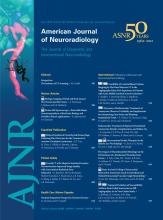Abstract
BACKGROUND AND PURPOSE: Recently we published a novel method of thrombus preparation for use in a swine model for evaluation of thrombectomy designs. The clot (fibrin rich clot) is characterized by its similarity in histologic characteristics to the thromboemboli recovered from stroke patients. The purpose of this latest study was to evaluate if the performance of a mechanical thrombectomy device was affected by the histologic characteristics of thromboembolus. Erythrocyte rich clot, which was created using exogenous thrombin, and the novel experimental clot with abundance of fibrin/cellular component were used for comparison. The Merci clot retriever was used for the evaluation and the angiographic outcomes were analyzed.
MATERIALS AND METHODS: Two histologically different types of experimental clot, a conventionally used thrombin-induced clot (erythrocyte-rich clot) and a novel experimental clot that is similar in histologic characteristics to the thromboemboli recovered from patients with stroke (fibrin-rich clot), were prepared. Eight extracranial arteries in swine were occluded with erythrocyte-rich clot (group A), and 8 were occluded with fibrin-rich clot (group B), and MT by using the Merci clot retriever device was performed. Angiographic results in each group were evaluated.
RESULTS: A total of 48 attempts at MT were made. The average number of attempts to achieve TIMI grade II or III recanalization was 2.75 times in group A and 4.5 times in group B (P < .001), respectively. The mean time to achieve recanalization was 15.5 minutes in group A and 81.5 minutes in group B (P < .01). Every vessel in group A showed recanalization (100%), whereas only 3 of 8 samples (37.5%) achieved recanalization in group B.
CONCLUSIONS: In this model, arteries occluded by fibrin-rich clot demonstrated a significantly lower recanalization rate, lower final TIMI score, and a longer mean recanalization time than did arteries occluded by erythrocyte-rich clot. The angiographic outcome of MT by using the Merci clot retriever system was influenced by the histologic characteristics of the occluding thromboembolus.
ABBREVIATIONS:
- IMAX
- internal maxillary artery
- LA
- lingual artery
- MT
- mechanical thrombectomy
- SCA
- superficial cervical artery
- TIMI
- thrombolysis in myocardial infarction
- UCLA
- University of California, Los Angeles
- © 2012 by American Journal of Neuroradiology











